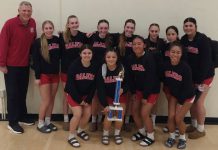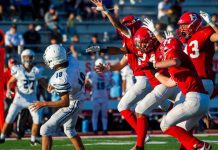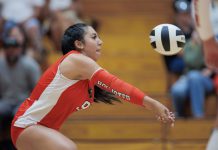1950s graduates acknowledge basketball, football leader for
success
Like many high school athletes, Bob Solano has fond memories of
his time on the basketball court and on the football field. Though
he and his friends just celebrated their 50th high school reunion
from Hollister High School, they remembered one teammate the
best
– their coach, Bud Presley.
”
When I went in as a freshman, we had one of the worst basketball
teams,
”
Solano said.
”
If we won one game a year, we were lucky. It was one of those
things that is kinda embarrassing to get beat by 40 or 50
points.
”
1950s graduates acknowledge basketball, football leader for success
Like many high school athletes, Bob Solano has fond memories of his time on the basketball court and on the football field. Though he and his friends just celebrated their 50th high school reunion from Hollister High School, they remembered one teammate the best – their coach, Bud Presley.
“When I went in as a freshman, we had one of the worst basketball teams,” Solano said. “If we won one game a year, we were lucky. It was one of those things that is kinda embarrassing to get beat by 40 or 50 points.”
By his sophomore year, 1954-55, the team had turned around its losing streak and Solano, along with other players, credited the change to their new coach. By his senior year, 1956-57, the basketball team went 16-4.
“He just had a way about him,” Solano said. “He could draw the best out of everybody. He could take anybody and make a basketball or football player out of them.”
Solano said the coach was able to communicate better with the team than other coaches who had worked with the team. Presley, he said, stressed the importance of the team being in shape.
“Everything was a team unit,” Solano said. “There were no stars on his team.”
The young men spent as much of their practice time running as doing other drills on the court and on the field.
“We were a small team and didn’t have any depth,” Solano said. “We were full- court press so we had to be in shape to play the whole game. He said we should be in shape to play five quarters, not just four.”
Presley stayed at the high school for just three years before moving on to coach at a junior college in the Bay Area. He continued to coach at the college level for years, and was even featured in a 1970s “Sports Illustrated” article about great college coaches.
“He knew how to handle kids and how to treat people with respect,” Solano said. “Everyone had nothing but respect for the man. He was fair.”
Solano recalled that their coach had let the players call their own offense and defensive plays during the games.
“It was unheard of,” he said. “That’s how much confidence he had in us.”
One thing Solano learned from Presley that he put into action when he coached flag football, Pop Warner football and high school teams was watching the the other team.
“He was so good – he had eyes like a hawk,” Solano said. “He saw everything he could while he was sitting in the stands.”
Presley watched the opponents and could quickly pick out weaknesses that could be used to the advantage of his players, Solano said.
“I used that when I coached…” Solano said. “I had a boxing club for five years and I could watch a fighter and by the end of one round, I could pick out every weakness.”
Over the weekend, Solano and his former teammates caught up on the places they’d moved to – some ended up in Alaska, some stayed local and others moved on and have come back – and the things they had done, which ranged from working as a coach, a judge and city manager. One person they all mentioned, according to Solano, was Presley.
“Everybody went on to be successful,” Solano said. “They will say it was because of Bud Presley. There was a big love for him this week.”









